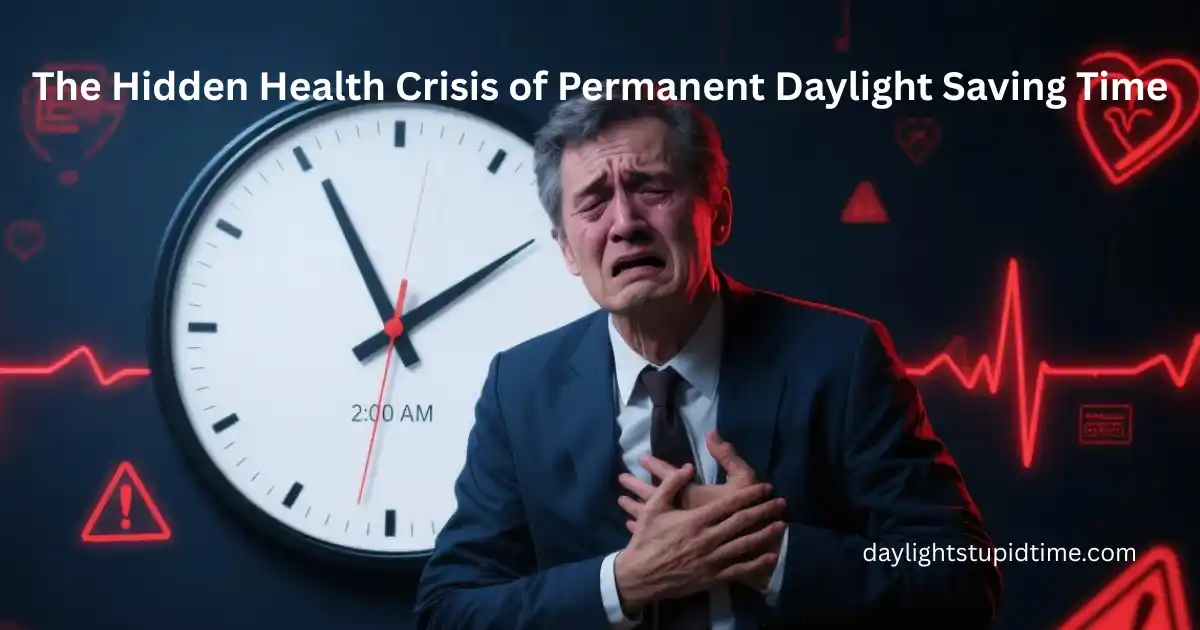The Hidden Health Crisis of Permanent Daylight Saving Time
The Sunshine Protection Act may sound beneficial, but beneath its appealing name lies a public health crisis waiting to unfold. As Congress considers making daylight saving time permanent, mounting scientific evidence reveals that this seemingly innocent time change could trigger a cascade of serious health consequences affecting millions of Americans.
The Cardiovascular Time Bomb
Recent research from the University of Connecticut has uncovered alarming cardiovascular risks associated with daylight saving time transitions. Dr. Shinsuke Tanaka’s groundbreaking study found a staggering 27% increase in heart attacks during the two weeks following the spring transition to daylight saving time. This increase is five times higher than what researchers have observed in other countries, suggesting that Americans may be particularly vulnerable to these time-related health disruptions.
The mechanism behind this deadly phenomenon lies in our body’s delicate circadian rhythm. When we artificially shift our clocks forward, we create a misalignment between our internal biological clock and the external environment. This disruption affects crucial cardiovascular functions, including blood pressure regulation, heart rate variability, and the timing of crucial hormones like cortisol and melatonin.
“Our internal clocks also become misaligned with the external environment,” explains Dr. Tanaka. “The evidence shows that sleep is important for cardiovascular diseases, and people do lose one hour of sleep during the spring forward, so then we can infer that this is one of the mechanisms.”
Under permanent daylight saving time, Americans would live with this cardiovascular stress year-round, potentially leading to thousands of preventable heart attacks, strokes, and other cardiovascular events.
The Mental Health Emergency
The mental health implications of permanent daylight saving time are equally devastating. Research indicates that adopting permanent standard time instead could prevent up to 5,000 suicides annually by reducing seasonal depression and maintaining proper circadian alignment.
The American Academy of Sleep Medicine warns that permanent daylight saving time would create a condition called “social jet lag” – a chronic misalignment between our biological clocks and social schedules. This condition is strongly associated with increased risks of:
- Major depressive disorder
- Seasonal affective disorder (SAD)
- Anxiety disorders
- Substance abuse
- Cognitive impairment
During winter months under permanent DST, sunrise would be delayed until after 8 AM in much of the country, and after 9 AM in northern states. This lack of morning sunlight is particularly problematic for individuals who experience seasonal affective disorder, as morning light exposure is crucial for mood regulation and mental health.
The Sleep Deprivation Epidemic
Perhaps most concerning is the chronic sleep disruption that permanent daylight saving time would impose on the American population. Currently, 71-84% of high school students already report getting insufficient sleep, largely due to the misalignment between their biological clocks and school schedules.
Permanent daylight saving time would exacerbate this crisis by:
- Delaying the body’s natural melatonin release
- Making it harder to fall asleep at appropriate times
- Forcing earlier wake times despite later sleep onset
- Creating chronic sleep debt across all age groups
The neurologist Dr. Joanna Fong-Isariyawongse emphasizes that “standard time follows the body’s natural circadian rhythm, which is primarily regulated by exposure to sunlight. Our internal clocks are most stable when morning light exposure occurs early in the day.”
The Circadian Science is Clear
The human circadian system evolved over millions of years to synchronize with the natural cycle of the sun. This internal timekeeper regulates not just sleep and wake cycles, but also:
- Hormone production (cortisol, melatonin, growth hormone)
- Body temperature fluctuations
- Immune system function
- Metabolism and digestion
- Cognitive performance and alertness
By artificially shifting our clocks forward permanently, we would be forcing 330 million Americans to live in a state of chronic circadian disruption. This isn’t just about feeling tired – it’s about fundamentally altering the biological processes that keep us healthy and alive.
Medical Community United in Opposition
The opposition from health professionals is overwhelming and unprecedented. The American Academy of Sleep Medicine, representing over 12,000 sleep medicine professionals, has taken a strong stance against permanent daylight saving time. Their position statement emphasizes that “standard time aligns best with human circadian biology and provides distinct benefits for public health and safety.”
Major health organizations echoing this opposition include:
- The National Safety Council
- The American Medical Association
- Sleep research societies worldwide
- Pediatric health organizations
The Path Forward
The evidence is unambiguous: permanent daylight saving time poses serious risks to public health. Instead of rushing toward a policy that could harm millions of Americans, Congress should consider the scientifically-supported alternative of permanent standard time.
As we face ongoing public health challenges, the last thing we need is legislation that would knowingly increase heart attacks, suicides, and chronic health conditions. The Sunshine Protection Act may promise brighter evenings, but it delivers darker mornings and even darker health outcomes for the American people.


